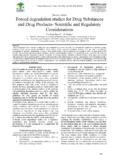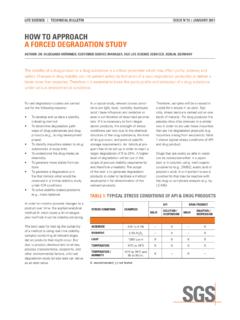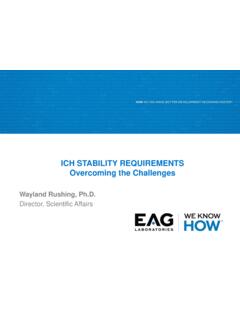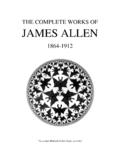Transcription of Q1B Photostability Testing of New Active Substances and ...
1 European Medicines Agency 7 Westferry Circus, Canary Wharf, London, E14 4HB, UK Tel. (44-20) 74 18 85 75 Fax (44-20) 75 23 70 40 E-mail: EMEA 2006 Reproduction and/or distribution of this document is authorised for non commercial purposes only provided the EMEA is acknowledged January 1998 CPMP/ICH/279/95 ICH Topic Q1B Photostability Testing of New Active Substances and Medicinal Products Step 5 NOTE FOR GUIDANCE ON THE Photostability Testing OF NEW Active Substances AND MEDICINAL PRODUCTS (CPMP/ICH/279/95) TRANSMISSION TO CPMP December 1995 TRANSMISSION TO INTERESTED PARTIES December 1995 COMMENTS REQUESTED BEFORE June 1996 FINAL APPROVAL BY CPMP December 1996 DATE FOR COMING INTO OPERATION January 1998 EMEA 2006 2 Photostability Testing OF NEW Active Substances AND MEDICINAL PRODUCTS ICH Harmonised Tripartite Guideline Table of Contents 1. GENERAL .. 3 PREAMBLE.
2 3 LIGHT SOURCES .. 5 PROCEDURE .. 5 2. Active 5 PRESENTATION OF SAMPLES .. 6 ANALYSIS OF SAMPLES .. 6 EVALUATION OF RESULTS .. 6 3. MEDICINAL 7 PRESENTATION OF SAMPLES .. 7 ANALYSIS OF SAMPLES .. 7 EVALUATION OF RESULTS .. 8 4. 8 QUININE CHEMICAL ACTINOMETRY .. 8 5. 9 6. 9 EMEA 2006 3 1. GENERAL The ICH Harmonised Tripartite Guideline covering the Stability Testing of New Active Substances and Medicinal Products (hereafter referred to as the Parent Guideline) notes that light Testing should be an integral part of stress Testing . This document is an annex to the Parent Guideline and addresses the recommendations for Photostability Testing . Preamble The intrinsic Photostability characteristics of new Active Substances and medicinal products should be evaluated to demonstrate that, as appropriate, light exposure does not result in unacceptable change.
3 Normally, Photostability Testing is carried out on a single batch of material selected as described under Selection of Batches in the Parent Guideline. Under some circumstances these studies should be repeated if certain changes are made to the product ( , formulation, packaging). Whether these studies should be repeated depends on the Photostability characteristics determined at the time of first submission of an application and the type of change made. The guideline primarily addresses the generation of Photostability information for submission in applications for marketing authorisations for new Active Substances and associated medicinal products. The guideline does not cover the Photostability of medicinal products after administration ( under conditions of use) and those applications not covered by the Parent Guideline.
4 Alternative approaches may be used if they are scientifically sound and justification is provided. A systematic approach to Photostability Testing is recommended covering, as appropriate, studies such as : i) Tests on the Active substance; ii) Tests on the exposed product outside of the immediate pack, and if necessary ; iii) Tests on the product in the immediate pack; and if necessary ; iv) Tests on the product in the marketing pack. The extent of product Testing should be established by assessing whether or not acceptable change has occurred at the end of the light exposure Testing as described in the Decision Flow Chart for Photostability Testing of Medicinal Products. Acceptable change is change within limits justified by the applicant. The formal labelling requirements for photolabile Substances and products are established by national requirements.
5 EMEA 2006 4 DECISION FLOWCHART FOR Photostability Testing OF MEDICINAL PRODUCTS IMMEDIATE PACK CHANGE? DIRECTLY EXPOSEDSTART ACCEPTABLECHANGE? IMMEDIATE PACKACCEPTABLE CHANGE? MARKETING ACCEPTABLE CHANGE? REDESIGN PACKAGE OR REFORMULATION FORMULATIONCHANGE? MARKETING PACK CHANGE?TEST END TEST END TEST END NO NO YES NO YES NO NO YES YES YES EMEA 2006 5 Light sources The light sources described below may be used for Photostability Testing . The applicant should either maintain an appropriate control of temperature to minimise the effect of localised temperature changes or include a dark control in the same environment unless otherwise justified. For both options 1 and 2, a pharmaceutical manufacturer/applicant may rely on the spectral distribution specification of the light source manufacturer.
6 Option 1 Any light source that is designed to produce an output similar to the D65/ID65 emission standard such as an artificial daylight fluorescent lamp combining visible and ultraviolet (UV) outputs, xenon, or metal halide lamp. D65 is the internationally recognised standard for outdoor daylight as defined in ISO 10977 (1993). ID65 is the equivalent indoor indirect daylight standard. For a light source emitting significant radiation below 320 nm, an appropriate filter(s) may be fitted to eliminate such radiation. Option 2 For option 2 the same sample should be exposed to both the cool white fluorescent and near ultraviolet lamp. 1. A cool white fluorescent lamp designed to produce an output similar to that specified in ISO 10977(1993) ; and 2. A near UV fluorescent lamp having a spectral distribution from 320 nm to 400 nm with a maximum energy emission between 350 nm and 370 nm; a significant proportion of UV should be in both bands of 320 to 360 nm and 360 to 400 nm.
7 Procedure For confirmatory studies , samples should be exposed to light providing an overall illumination of not less than million lux hours and an integrated near ultraviolet energy of not less than 200 watt hours/square meter to allow direct comparisons to be made between the substance and product. Samples may be exposed side-by-side with a validated chemical actinometric system to ensure the specified light exposure is obtained, or for the appropriate duration of time when conditions have been monitored using calibrated radiometers/lux meters. An example of an actinometric procedure is provided in the Annex. If protected samples ( , wrapped in aluminium foil) are used as dark controls to evaluate the contribution of thermally induced change to the total observed change, these should be placed alongside the authentic sample.
8 2. Active SUBSTANCE For Substances , Photostability Testing should consist of two parts: forced degradation Testing and confirmatory Testing . The purpose of forced degradation Testing studies is to evaluate the overall photosensitivity of the material for method development purposes and/or degradation pathway elucidation. This Testing may involve the substance alone and/or in simple solutions/suspensions to validate the analytical procedures. In these studies , the samples should be in chemically inert and transparent containers. In these forced degradation studies , a variety of exposure conditions may be used, depending on the photosensitivity of the substance involved and the intensity of the light sources used. For development and validation purposes it is appropriate to limit exposure and end the studies if extensive decomposition occurs.
9 For photostable materials, EMEA 2006 6 studies may be terminated after an appropriate exposure level has been used. The design of these experiments is left to the applicant s discretion although the exposure levels used should be justified. Under forcing conditions, decomposition products may be observed that are unlikely to be formed under the conditions used for confirmatory studies . This information may be useful in developing and validating suitable analytical methods. If in practice it has been demonstrated they are not formed in the confirmatory studies , these degradation products need not be further examined. Confirmatory studies should then be undertaken to provide the information necessary for handling, packaging, and labelling (see section , Procedure, and , Presentation, for information on the design of these studies ).
10 Normally, only one batch of substance is tested during the development phase, and then the Photostability characteristics should be confirmed on a single batch selected as described in the Parent Guideline if the substance is clearly photostable or photolabile. If the results of the confirmatory study are equivocal, Testing of up to two additional batches should be conducted. Samples should be selected as described in the Parent Guideline. Presentation of samples Care should be taken to ensure that the physical characteristics of the samples under test are taken into account and efforts should be made, such as cooling and/or placing the samples in sealed containers, to ensure that the effects of the changes in physical states such as sublimation, evaporation or melting are minimised. All such precautions should be chosen to provide minimal interference with the exposure of samples under test.


















